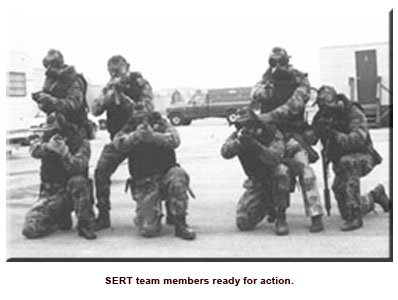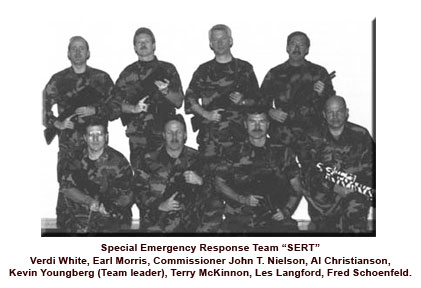SERT
Following the Marion incident, Commissioner Bodrero ordered the creation of a highly trained special response team. Applicants were subjected to physical, mental, psychological, and task oriented testing. The team was selected and organized in July 1988. This team became known as the Special Emergency Response Team (SERT). The first SERT members included Kevin Youngberg, Earl Morris, Terry McKinnon, Les Langford, Fred Schoenfeld, Al Christianson, and Verdi White.
During the following year, the SERT team trained with SWAT teams from the Utah Department of Corrections, the Salt Lake City Police Department, and the Provo Police Department. In November 1988, the SERT team completed a sniper course taught by the United States Marine Corp.
The SERT team then employed the expertise of the Prince George County Police, Emergency Services Team. Prince George County, Maryland, borders Washington D. C. They host a national academy for SWAT/SERT teams. The DPS SERT team completed the Prince George High Risk Special Response Training.
Team member Earl Morris learned about an Israeli based organization which specialized in anti-terrorist training. In September 1989, Utah Peace Officer Standards and Training sponsored ATLAS (Anti-Terror Logistics and Systems). During this five-day course, 27 officers from Utah, Arizona, California, Wyoming, Wisconsin and NASA, received training in automatic weapons, hostage incidents, building assaults, and raid strategies. The head instructor was retired Colonel Muki Betser, field commander of the force that raided Entebbe, Uganda, and rescued 103 hostages in July 1976. All instructors had served with the Israeli Special Forces. This training was only the second time that ATLAS had offered such training in the United States. The intense training consisted of 18 to 20 hours per day for five days, and was designed to test the officers both physically and mentally to the limit.
DPS SERT also received training from five officers from the London Metropolitan Police – Tactical Division. This course was called Tactical Hostage Rescue Entry Assault Training (THREAT). During this training, officers learned to coordinate all elements of a hostage rescue mission. Emphasis was placed on surprise, aggression, momentum, speed, control, communication, accurate shooting, team work, and training as the formula for success.
During October 1990, agents with the U. S. Drug Enforcement Agency (DEA) conducted Utah’s first clandestine drug laboratory safety certificate program at Camp Williams. Members of the Department of Public Safety which attended this training included agents with the Utah Division of Investigations (UDI), crime lab technicians, Utah Highway Patrol hazardous material experts, and SERT team members.
According to 1990 DEA statistics, Utah ranked third nationally, behind California and New Jersey, in the number of clandestine (illegal) drug laboratory raids and chemical precursor seizures.
A precursor chemical is a substance that is mandatory in the chemical “recipe” of a compound in order to make an illicit substance. In 1990, precursors were easily purchased in Utah. The Department of Public Safety spent several years on Capitol Hill working for passage of legislation which greatly reduced the volume of precursors which are used in the manufacture of illicit drugs.
 Since it was created, the Special Emergency Response Team has proven to be a valuable resource to the Department of Public Safety. The SERT team is utilized for VIP security, during high profile drug buys, serving felony warrants, executing high profile or dangerous search warrants, during hostage or barricaded suspect incidents, during courtroom security on high profile cases, transporting high risk prisoners, and as additional resources during major events such as motorcycle rallies in remote areas of the state.
Since it was created, the Special Emergency Response Team has proven to be a valuable resource to the Department of Public Safety. The SERT team is utilized for VIP security, during high profile drug buys, serving felony warrants, executing high profile or dangerous search warrants, during hostage or barricaded suspect incidents, during courtroom security on high profile cases, transporting high risk prisoners, and as additional resources during major events such as motorcycle rallies in remote areas of the state.

